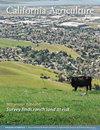Watering the Emerald Triangle: Irrigation sources used by cannabis cultivators in Northern California
IF 1.1
4区 农林科学
Q2 AGRICULTURE, MULTIDISCIPLINARY
引用次数: 12
Abstract
Water use by cannabis cultivators represents an emerging threat to surface flows in Northern California's sensitive watersheds. To date, however, no data has been available to formally assess where cannabis sites source their water. This study analyzed data from annual reports, covering the year 2017, submitted by 901 cannabis cultivators enrolled in the Cannabis Waste Discharge Regulatory Program administered by the North Coast Regional Water Quality Control Board. The analysis identified cannabis cultivators' most common sources for water extraction, monthly patterns for each water source and differences between sites compliant and not compliant with the cannabis program. The most commonly reported source of water was wells (58% of sites), with most extraction from wells occurring during the growing season (April through October). Surface water diversions (22% of sites) and spring diversions (16% of sites) were the most common sources after wells, with extractions from these sources distributed much more evenly across the year. Although nearly one-third of noncompliant sites (33%) used wells, this source was more than twice as frequently reported among compliant sites (68%), indicating that wells may become increasingly common as more sites become part of the regulated cannabis industry.浇灌翡翠三角:北加州大麻种植者使用的灌溉来源
大麻种植者的用水对北加州敏感流域的地表水流构成了新的威胁。然而,到目前为止,还没有数据可以正式评估大麻产地的水源。本研究分析了由北海岸区域水质控制委员会管理的大麻废物排放监管计划中注册的901名大麻种植者提交的2017年年度报告中的数据。分析确定了大麻种植者最常见的水提取来源,每个水源的月度模式以及符合和不符合大麻计划的地点之间的差异。最常见的水源是水井(58%的地点),大多数水井的取水发生在生长季节(4月至10月)。地表水改道(22%的站点)和泉水改道(16%的站点)是水井之后最常见的水源,这些水源的提取在全年中分布得更为均匀。尽管近三分之一的不合规场所(33%)使用井,但合规场所(68%)使用井的频率是其两倍多,这表明随着越来越多的场所成为受监管的大麻行业的一部分,井可能会变得越来越普遍。
本文章由计算机程序翻译,如有差异,请以英文原文为准。
求助全文
约1分钟内获得全文
求助全文
来源期刊

California Agriculture
农林科学-农业综合
CiteScore
2.40
自引率
7.70%
发文量
17
审稿时长
>12 weeks
期刊介绍:
Information not localized
 求助内容:
求助内容: 应助结果提醒方式:
应助结果提醒方式:


